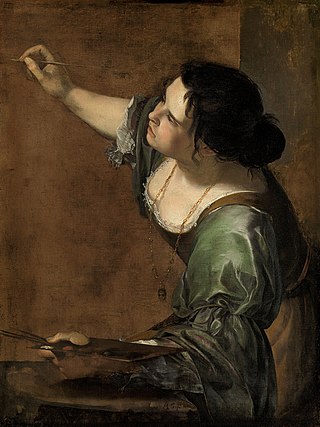
Artemisia Lomi or Artemisia Gentileschi was an Italian Baroque painter. Gentileschi is considered among the most accomplished 17th-century artists, initially working in the style of Caravaggio. She was producing professional work by the age of 15. In an era when women had few opportunities to pursue artistic training or work as professional artists, Gentileschi was the first woman to become a member of the Accademia di Arte del Disegno in Florence and she had an international clientele.

Self-Portrait as the Allegory of Painting, also known as Autoritratto in veste di Pittura or simply La Pittura, was painted by the Italian Baroque artist Artemisia Gentileschi. The oil-on-canvas painting measures 98.6 by 75.2 centimetres and was probably produced during Gentileschi's stay in England between 1638 and 1639. It was in the collection of Charles I and was returned to the Royal Collection at the Restoration (1660) and remains there. In 2015 it was put on display in the "Cumberland Gallery" in Hampton Court Palace.

Venus and Cupid (Sleeping Venus) is a circa 1626 painting by Artemisia Gentileschi in the Virginia Museum of Fine Arts. Venus and Cupid is a depiction of a sleeping Venus, who reclines on a blue bed covering and rich crimson and gold tasseled pillow. She wears nothing except a thin wisp of transparent linen around her thigh. Her son Cupid fans her with richly colored peacock feathers as she drifts to sleep. He is gazing at her with an adored, raptured expression. In the background, there is a window looking out onto a moonlight landscape where a temple to the goddess lies. Venus's face has full cheeks, heavy lids, a prominent nose, and small protruding chin—all features of Gentileschi's own face. The body movements are natural: Venus's hand rests lightly on her side, her legs are gently laid together. The work blends together realism and classicism through its iconography and the artist's style.

Susanna and the Elders is a 1610 painting by the Italian Baroque artist Artemisia Gentileschi and is her earliest-known signed and dated work. It was one of Gentileschi's signature works. She painted several variations of the scene in her career. It hangs at Schloss Weißenstein in Pommersfelden, Germany. The work shows a frightened Susanna with two men lurking above her while she is in the bath. The subject matter comes from the deuterocanonical Book of Susanna in the Additions to Daniel. This was a popular scene to paint during the Baroque period.

Esther Before Ahasuerus is a painting by the 17th-century Italian artist Artemisia Gentileschi. It shows the biblical heroine Esther going before Ahasuerus to beg him to spare her people. The painting is now in the Metropolitan Museum of Art in New York, having been donated to the museum by Elinor Dorrance Ingersoll in 1969. It is one of Gentileschi's lesser known works, but her use of lighting, characterization, and style help in successfully portraying Esther as a biblical heroine as well as the main protagonist of the work.

Judith and her Maidservant is a c. 1615 painting by the Italian baroque artist Artemisia Gentileschi. The painting depicts Judith and her maidservant leaving the scene where they have just beheaded general Holofernes, whose head is in the basket carried by the maidservant. It hangs in the Pitti Palace, Florence.
This is an ongoing bibliography of work related to the Italian baroque painter Artemisia Gentileschi.
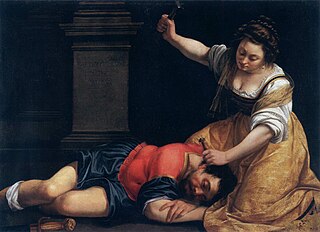
Jael and Sisera is a painting by the Italian Baroque artist Artemisia Gentileschi, executed around 1620.

Self-Portrait as a Female Martyr, is also known as the Self-Portrait as a Martyr Saint. This painting was created by the Italian female artist, Artemisia Gentileschi. This self-portrait was made around 1615 depicting the artist herself as a martyr. It is one of two paintings by Gentileschi painted with oil on a wood panel. This self-portrait is currently in a private collection in the United States.

Santa Cecilia is an early painting, from c. 1620, by the Baroque painter Artemisia Gentileschi, a painter described as "a grand exception in the history of art - a successful woman painter in an era in which art was dominated by men."
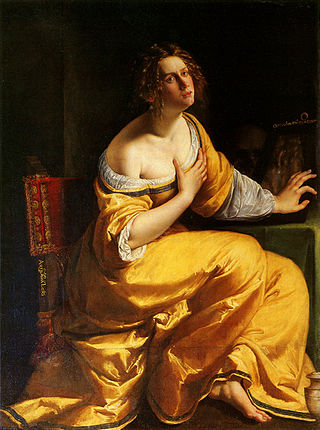
Penitent Magdalene is a 1616–1618 painting by the Italian baroque artist Artemisia Gentileschi. This painting hangs in the Pitti Palace in Florence. The subject is the biblical figure Mary Magdalene, but the painting references another biblical woman, Mary, the sister of Lazarus. This painting was likely painted during Gentileschi's Florentine period.
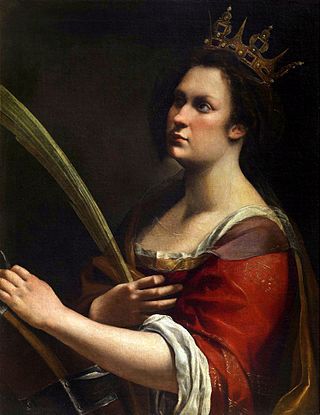
Saint Catherine of Alexandra is a painting by the Italian Baroque artist Artemisia Gentileschi. It is in the collection of the Uffizi, Florence. Gentileschi likely used the same cartoon or preparatory drawing to create both this painting and the Self-Portrait as Saint Catherine of Alexandria (1615–1617), now in the National Gallery, London.
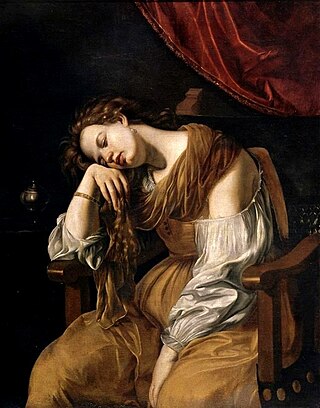
Penitent Magdalene is a painting by the Italian artist Artemisia Gentileschi. It hangs in Seville Cathedral. It has probably been in the cathedral since the late 17th century. She returned to the subject later in the 1620s in Mary Magdalene as Melancholy.

The Self Portrait of Italian baroque artist Artemisia Gentileschi was painted in the early 1630s. It currently hangs in the Palazzo Barberini, Rome. It is one of many paintings where Gentileschi depicts herself. Beyond self-portraits, her allegorical and religious paintings often featured herself in different guises.

Simon Rollo Gillespie is a British conservator-restorer of fine art, and an art historian. He is known particularly for his work with Early British and Tudor portraits, although his practice extends across all periods from early paintings to contemporary artworks. Gillespie has been restoring art since 1978, and he appears frequently on the BBC Four series Britain's Lost Masterpieces, having previously appeared on the BBC1 art programme Fake or Fortune.

Cleopatra is a 1611-1612 oil on canvas painting of Cleopatra by Artemisia Gentileschi, now in the private Etro collection in Milan.

Mary Magdalene in Ecstasy is a painting by the Italian baroque artist Artemisia Gentileschi. It is in the Doge’s Palace in Venice.

David and Goliath is a painting of David and Goliath by the seventeenth-century artist Artemisia Gentileschi. It is held by a private collection in the United Kingdom.

Tarquin and Lucretia is a 1620–1650 oil on canvas painting by Artemisia Gentileschi. It hangs in the Great Hall of the Neues Palais in Potsdam. It is one of three paintings that Gentileschi painted of Lucretia, the wife of Roman consul and general Tarquinus, at the moment of her suicide. The other two versions are in a private collection in Milan and The Getty Museum in Los Angeles.

Aurora is a c.1625-1627 painting by the Italian artist Artemisia Gentileschi, depicting the Roman goddess of dawn. It is part of a private collection in Rome.


















